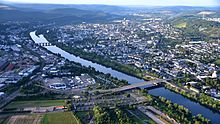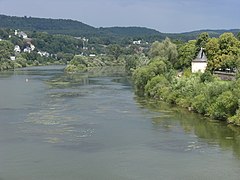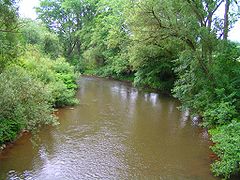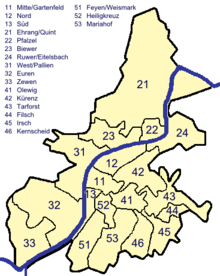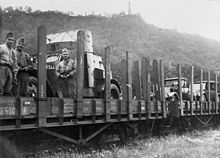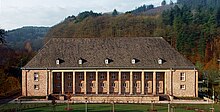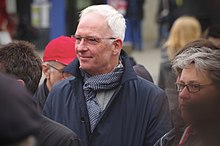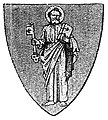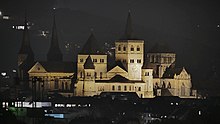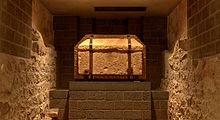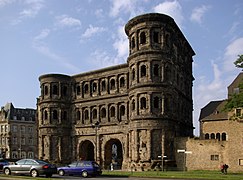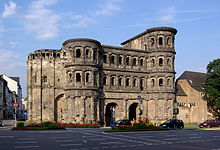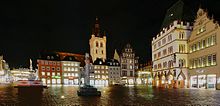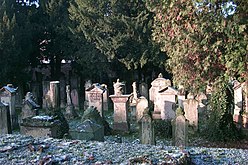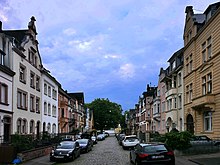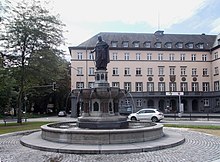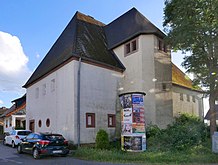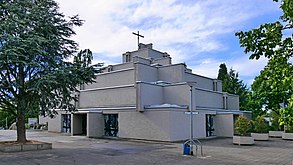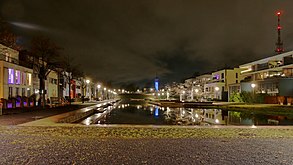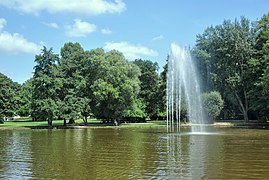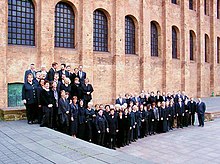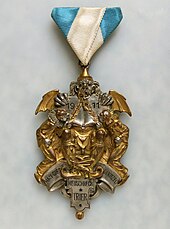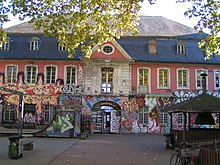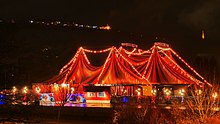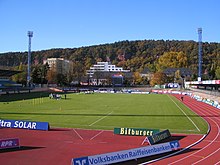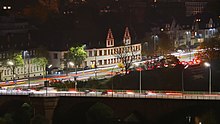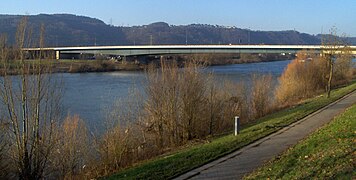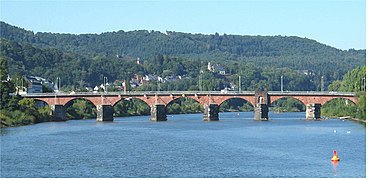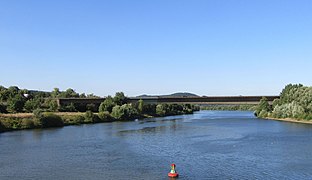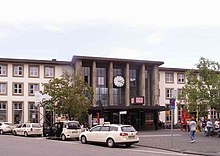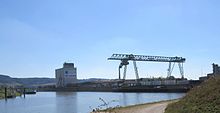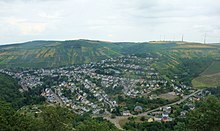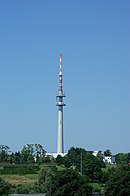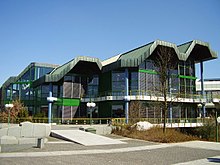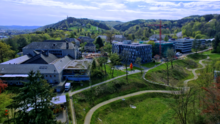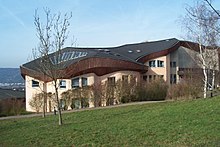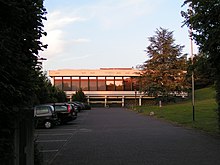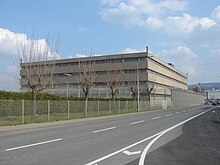trier
| coat of arms | Germany map | |
|---|---|---|
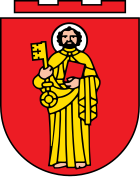
|
Coordinates: 49 ° 46 ' N , 6 ° 39' E |
|
| Basic data | ||
| State : | Rhineland-Palatinate | |
| Height : | 136 m above sea level NHN | |
| Area : | 117.13 km 2 | |
| Resident: | 110,674 (Dec 31, 2020) | |
| Population density : | 945 inhabitants per km 2 | |
| Postcodes : | 54290, 54292, 54293, 54294, 54295, 54296 | |
| Area code : | 0651 | |
| License plate : | TR | |
| Community key : | 07 2 11 000 | |
| NUTS : | DEB21 | |
| City structure: | 19 districts | |
City administration address : |
At the Augustinerhof 54290 Trier |
|
| Website : | ||
| Lord Mayor : | Wolfram Leibe ( SPD ) | |
| Location of the city of Trier in Rhineland-Palatinate | ||
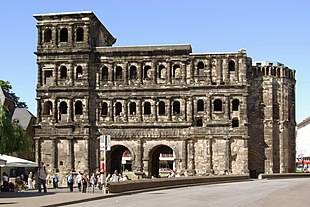
Constantine the Great , Roman Emperor, also resided in Trier
Baldwin of Luxembourg , one of the most important electors of Trier; Representation on the Baldwin fountain
Trier ( French Trèves , Luxembourgish Tréier ) (Latin Augusta Treverorum ) is a city in the west of Rhineland-Palatinate . With around 110,000 inhabitants, it is the fourth largest city after Mainz , Ludwigshafen am Rhein and Koblenz .
The city was founded more than 2000 years ago under the name Augusta Treverorum (from the second half of the 3rd century Treveris ) and claims the title of the oldest city in Germany . Trier relies here on the longest history as a recognized already by the Romans city , as opposed to a settlement or a camp .
The Roman monuments in Trier have been a UNESCO World Heritage Site since 1986 . These include the amphitheater , Barbarathermen , Kaiserthermen , Konstantinbasilika , Porta Nigra , Roman bridge and the Igel column in Igel . The Romanesque cathedral and the early Gothic Church of Our Lady are also part of the Trier World Heritage Site . In addition, there are cultural monuments in Trier from almost all epochs from early history to the 21st century.
Trier is the seat of the University of Trier and the University of Trier , the administration of the district Trier-Saarburg , the administration of the Verbandsgemeinde Trier-Land , the supervisory and service directorate (ADD, until 1999 district government Trier ), several offices of the state investigation office (LUA) , one Office of the State Office for Social Affairs, Youth and Welfare in Rhineland-Palatinate , a Roman Catholic diocese ( Diocese of Trier , the oldest north of the Alps ) and the Protestant church district of Trier .
geography
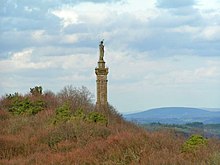
Trier lies in the middle of a valley widening of the middle Moselle valley with the main part on the right bank of the river. Wooded slopes partly covered with vineyards rise to the plateaus of the Hunsrück in the southeast and the Eifel in the northwest. The border with the Grand Duchy of Luxembourg ( Wasserbillig ) is about 15 km from the city center. The next larger cities are Saarbrücken , about 80 kilometers southeast, Koblenz , about 100 kilometers northeast, and Luxembourg City , about 50 kilometers west of Trier.
Trier Switzerland is an older name for the local recreation and excursion area of the city of Trier to the left of the Moselle. By 1905, Trier Switzerland had a capacity of around 1,800 guests who could have been catered for in nine inns in this area at the same time.
Due to the predominantly rural surrounding area, Trier has - for its size - a relatively large catchment area, which is made up of large parts of the Moselle valley, the lower Saar valley , the Eifel and Hunsrück; see also: Trier region .
The altitude of Trier extends from 124 m above sea level. NHN on the Moselle shortly before Schweich up to 427 m above sea level. NHN on the Kuppensteiner Wild near Trier-Irsch . The height of the city center, measured at the main market , is 137 m above sea level. NHN .
On the right side of the Moselle is the Petrisberg , to the left of the Moselle are the Pulsberg / Markusberg with the Marian column and the Kockelsberg . Tributaries of the Moselle are from the right Kobenbach , Aulbach , Olewiger Bach , Aveler Bach , Gruberbach , Meierbach and Ruwer and from the left Zewenerbach , Eurenerbach , Sirzenicher Bach with Gillenbach , Biewerbach , Kyll and Quintbach .
Trier is the name of the measuring table sheet No. 6205 of the topographic map on a scale of 1: 25,000.
Neighboring communities
The independent city of Trier is completely enclosed by the Trier-Saarburg district . In the immediate vicinity, only a few kilometers away, are the Eifel district Bitburg-Prüm and the district Bernkastel-Wittlich .
Neighboring municipalities are clockwise (starting in the north):
- Schweich , Longuich , Kenn and again Longuich in the area of the Verbandsgemeinde Schweich on the Roman Wine Route
- Mertesdorf , Kasel , Waldrach , Morscheid , Korlingen and Gusterath in the area of the Ruwer community
- Hockweiler and Franzenheim in the area of the Trier-Land association
- Konz and Wasserliesch in the area of the Verbandsgemeinde Konz
- Igel , Trierweiler , Aach , Newel , Kordel and Zemmer in the area of the Trier-Land association
City structure
The urban area of Trier is divided into 19 districts. In each local district there is a local advisory council consisting of 9 to 15 members and a local councilor . The local councils are to be heard on important matters affecting the local district. The final decision on a measure rests with the city council. The local advisory councils can also independently decide on smaller measures in the local district within the framework of a budget allocated to them.
The local districts contain a total of 28 city districts, 10 of which are identical in their characteristics to the local district.
- Districts with area and population (primary and secondary residence)
| No. | Local district with associated city districts |
Area in ha |
Residents Dec. 31, 2006 |
Residents Dec. 31, 2013 |
Residents Dec. 31, 2019 |
|---|---|---|---|---|---|
| 11 | Mitte / Gartenfeld (old town, Gartenfeld) | 294.7 | 12,648 | 12,256 | 12,784 |
| 12th | North (Nells Ländchen, Maximin) | 375.6 | 14,256 | 13,628 | 14,231 |
| 13th | South (Barbara, Matthias) | 164.8 | 9,409 | 9,386 | 9,428 |
| 21 | Ehrang / Quint (Ehrang, Quint) | 2,522.9 | 9,397 | 9.133 | 9.130 |
| 22nd | Pfalzel | 238.5 | 3,558 | 3,543 | 3,517 |
| 23 | Biewer | 515.6 | 1,985 | 1,860 | 1.934 |
| 24 | Ruwer / Eitelsbach (Ruwer, Eitelsbach) | 910.3 | 3,142 | 3,020 | 3,039 |
| 31 | West / Pallien (Pallien, Trier-West) | 841.2 | 7.117 | 7,053 | 7,406 |
| 32 | Yours | 1,271.5 | 4.116 | 4,271 | 4,280 |
| 33 | Zewen | 783.6 | 3,695 | 3,564 | 3,621 |
| 41 | Olewig | 305.4 | 3,312 | 3,076 | 3,271 |
| 42 | Kürenz (Old-Kürenz, New-Kürenz) | 584.6 | 8,578 | 9,567 | 10,280 |
| 43 | Tarforest | 550.2 | 6,827 | 6,688 | 6,692 |
| 44 | Filsch | 149.6 | 830 | 836 | 1,514 |
| 45 | Irsch | 395.0 | 2,410 | 2,290 | 2.211 |
| 46 | Kernscheid | 381.6 | 999 | 936 | 900 |
| 51 | Feyen / Weismark (Feyen, Weismark) | 538.3 | 5,845 | 5,866 | 7,081 |
| 52 | Heiligkreuz (Alt-Heiligkreuz, New-Heiligkreuz) | 203.2 | 6,766 | 6,676 | 6,840 |
| 53 | Mariahof | 678.5 | 3.212 | 3,031 | 2,979 |
| City of Trier | 11,705.1 | 108.102 | 106,680 | 111.138 |
climate
The city is located in the temperate climate zone . The average annual temperature is 9.3 ° C and the average annual rainfall is 774 millimeters. In the measurement period between 1993 and 2013, the annual mean temperature was 10.09 ° C. The average annual precipitation in the same period was 765.9 mm, so it has not changed noticeably. The warmest months are June to August with an average of 16.1 to 17.8 ° C and the coldest December to February with an average of 0.6 to 1.6 ° C. Most of the precipitation falls from October to December with an average of 70 to 80 millimeters, the lowest in February and April with an average of 52 millimeters. The precipitation is in the middle third of the values recorded in Germany. Lower values are registered at 52% of the measuring stations of the German Weather Service . In December there is 1.5 times more rainfall than in April. Precipitation varies only minimally and is extremely evenly distributed over the year. At only 1% of the measuring stations, lower seasonal fluctuations are registered than in Trier.
| trier | ||||||||||||||||||||||||||||||||||||||||||||||||
|---|---|---|---|---|---|---|---|---|---|---|---|---|---|---|---|---|---|---|---|---|---|---|---|---|---|---|---|---|---|---|---|---|---|---|---|---|---|---|---|---|---|---|---|---|---|---|---|---|
| Climate diagram | ||||||||||||||||||||||||||||||||||||||||||||||||
| ||||||||||||||||||||||||||||||||||||||||||||||||
|
Average monthly temperatures and precipitation for Trier
|
|||||||||||||||||||||||||||||||||||||||||||||||||||||||||||||||||||||||||||||||||||||||||||||||||||||||||||||||||||||||||||||||||||||||||||||||||||||||||||||||||||||
On August 8, 2003, during the heat wave in Europe in 2003 , a heat record of 39 ° C was measured in Trier.
Spatial planning
In Rhineland-Palatinate, Trier is one of the five regional centers , for the middle centers Bernkastel-Kues , Bitburg , Daun , Gerolstein , Hermeskeil , Konz , Neuerburg , Prüm , Saarburg , Traben-Trarbach and Wittlich .
Trier is a co-founder of the “German Regiopole Network” founded in Rostock in March 2016 .
In the town of Trier there is a strong demand -überhang for rental apartments and condominiums: Throughout Germany there were in Trier according to a survey by the Federal Institute for Building, Urban Affairs and Spatial Development (BBSR) between 2005 and 2010, the highest increase in rents. The district of Trier-Saarburg is in third place in the nationwide ranking with a rent increase of 13.4 percent. The reason for this development is the geographical proximity of Trier to Luxembourg .
story
Trier is a city founded by the Romans and was originally called Augusta Treverorum , as a city of the Emperor Augustus and the Treveri , who were the Celtic tribe who settled in the region. In late antiquity the place was very important and was called Treveris . The current place name Trier is derived from this name.
prehistory
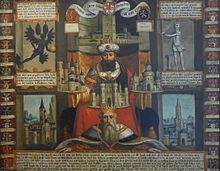
According to the founding legend of Trier, which was first recorded in writing in the Gesta Treverorum in 1105 , Trebeta , the son of the Assyrian king Ninus , is said to have founded Trier 1300 years before the rise of Rome . This would be around 2050 BC. Been. This is also indicated by the inscription from 1684 on the Red House on Trier's main market : “ANTE ROMAM TREVERIS STETIT ANNIS MILLE TRECENTIS. PERSTET ET AETERNA PACE FRUATUR. "(" Trier stood before Rome for a thousand and three hundred years. May it continue and enjoy an eternal peace. ")
The Hüttingen an der Kyll site north of Trier is considered to be one of the oldest archaeological evidence of human activity in this area. Their artifacts , including micro-tips, core- foot blades and core stones , can be traced back to the 9th millennium BC. To date. Possibly it was a hazelnut roasting place . In Mannebach also found traces of Mesolithic hunters, fishermen and gatherers. Additional sites from the more distant area were added, so that a raw material catchment area of 15,000 to 20,000 km² could be determined. Thus the 'activity space' of these groups was considerably larger than in the neighboring areas and at the same time it was of great stability over several millennia. This is likely to be related to similarly stable communication and exchange structures, which mainly reached far west. A development with boats via the regional river system, for example towards the Ardennes , probably played an important role.
Findings in the urban area reveal ceramic settlements from the older Neolithic period . However, no urban settlement can be expected here at this time.
Members of the Celtic tribe of the Treveri have settled in today's urban area since the last centuries before Christianity .
Roman Empire

According to reliable sources, the city of Trier is of Roman origin: at the foot of a 30 BC. The Romans founded the military camp on the Petrisberg , which was built on the Petrisberg and was abandoned after a few months, on March 3rd, most likely in 16 BC. BC, according to the rite of limitation, the city of Augusta Treverorum ( city of Augustus in the land of the Treveri ). The honor of being named after Augustus was otherwise only granted to Autun (Augustodunum) in Gaul / France, Aosta , Augsburg and Augst in northern Switzerland. Under Emperor Claudius the addition Colonia was added - Colonia Augusta Treverorum . Buildings such as the Barbarathermen , the amphitheater and the 6.4 kilometer long city wall with the still preserved northern city gate, the Porta Nigra , bear witness to the wealth and great importance that the city achieved by the end of the 2nd century.
Trier became a bishopric in the second half of the third century at the earliest ; the first bishop was the Eucharius . From 271 to 274 the city was the residence of the Gallo-Roman counter-emperor Tetricus I. In 275 Trier was destroyed by the Alemanni invasion . From 293 to 392 the city, now called Treveris , was one of the residences of the Roman emperors in the west (see also late antiquity ).
Under the reign of Constantine the Great (306–337), the city was rebuilt and buildings such as the palace auditorium (today's Constantine Basilica ) and the imperial baths were erected. In 326, parts of the private residential palaces of the imperial family were changed and expanded into a large double basilica, the remains of which can still be seen today in the area of the cathedral and the Church of Our Lady . From 318 Trier was the seat of the Gallic Prefecture , one of the two highest authorities in the west of the Roman Empire. From 328 to 340 Emperor Constantine II resided here. From 367 to 392 Trier was again the seat of government of the Roman Empire under Valentinian I , Gratian , Magnus Maximus and Valentinian II and at the same time the largest city north of the Alps with 80,000 to 100,000 inhabitants . In 407, shortly after the invasion of Gaul by the Vandals , Alans and Suebi , the Gallic prefecture was moved to Arles on the Rhone . In the 5th century Trier was conquered repeatedly, probably around 413 and 421, by the Franks and in 451 by the Huns under Attila . Rhenish Franks seized the metropolis around 455, but lost it again a few years later. Around 475, the city, which was in the meantime administered by Arbogast the Younger , was finally taken by the Franks.
middle Ages

At the end of the 5th century Trier came under the rule of the Franks under King Clovis . The Franconian counts took their seat in the outbuildings of the Constantine basilica , which was probably already in ruins, and from there administered the extensive royal estate in Trier and the surrounding area. They expanded the ancient palace auditorium into a royal palace (palatium) and fortress, bricked up the windows, put on battlements and redesigned the apse into a pagan tower .
In 882 Trier was conquered during a raid by the Vikings and almost completely destroyed. In 892 Trier was haunted a second time by the Vikings and sacked again. Due to the Treaty of Verdun Lorraine , it was incorporated into Eastern Franconia under Henry I in 925 . At first the city was administered by the Counts of Triergau ; In 902, King Ludwig gave the child to the Archbishop Radbod essential sovereign rights as well as the income of the royal palatinate. With this, the city of Trier came into the possession of the archbishops, who, however, had to leave the political administration tasks to the archbishop's bailiffs for a long time , the powerful count palatine near the Rhine . The residence of the archbishops was the bishop's court within the cathedral immunity, adjacent to the Church of Our Lady ; it was not until 1197 that the palatium was mentioned as the episcopal residence; previously it had only been used as a refuge because of the particular strength and strength of the ancient masonry. This and Trier's status as Roma secunda, which has been asserted since the second half of the 10th century, may have led to the move. In the 12th century, the bishops also won the secular possessions of the imperial abbey of St. Maximin and the bailiwick rights in Kurtrier. The Palatium was over the centuries for low and high castle and finally to the Electoral Palace extended.
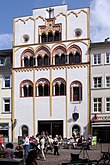
In 957 the city received important market rights; it has had a seal since 1149 . Since the 10th century Trier strove to become imperial immediately . In 1212 the city received a charter from Emperor Otto IV , which Conrad IV confirmed. In 1309, however, it had to recognize the jurisdiction of the archbishop again, at that time the important Baldwin of Luxembourg (see also the Electorate of Trier ). Its status as an archbishop's city was confirmed by Emperor Charles IV in 1364 and by the Imperial Court of Justice in 1580 ; however, the pursuit of imperial immediacy finally failed in 1583. Until the end of the old empire, the city remained the capital - if not the residence - of the electoral state named after it . It was headed by a jury that was supplemented by Archbishop Jakob I von Sierck in 1443 by appointing two mayors. In 1473 Emperor Friedrich III came. and Duke Charles the Bold of Burgundy together in Trier. In the same year a university was founded in Trier, which was abolished in 1797 under Napoleon.
After the cathedral ring was fortified at the end of the 10th century, Archbishop Theoderich II and his successor Arnold II built a wall ring around the city in the 13th century. The belt, which corresponds to today's Alleenring, covered an area of about 138 hectares. The Porta Nigra continued to serve as the northern city gate ; the ruins of the Kaiserthermen and the Barbarathermen were integrated into the southern part of the wall as corner bastions; both were secured by new towers occupied by ministerials . A number of Romanesque residential towers were also built in the city , of which only a few, such as the Frankenturm , have survived.
- Historical cityscapes
City view in the Schedelschen Weltchronik , woodcut by Michael Wolgemut in the edition by Johann Schönsperger (1497)
Engraving by M. Merian (1646), status from approx. 1548 after a drawing by Simon Reichwein
Map by Nicolas de Fer (1692): Trier and the surrounding area under French occupation
Wood engraving (northeast view) by Hubert Clerget (1885)
Modern times until after the First World War
In 1512 a Reichstag took place in Trier , at which the division of the imperial circles was finally determined. In September 1522, the Imperial Knight Franz von Sickingen besieged Trier for several days. His artillery bombarded the city area - including from the mountain heights, which were later given the name " Franzensknppchen ". In addition, Sickingen had letters of arrows shot into the city. On the slips of paper, he assured the population that he would not do anything against the citizens of Trier, but would only take action against the elector and the clergy. The people of Trier were not impressed by this; therefore Sickingen's army withdrew after a few days.
Dietrich Flade , lawyer, electoral governor and rector of the University of Trier , had led numerous witch trials and pronounced death sentences in his capacity as witch judge . In 1588 he got himself into a witch trial. He was arrested on July 4, 1588 on the orders of Elector Johann von Schönenberg and sentenced to death by fire on September 18, 1589. The sentence was carried out on the same day at the execution site in what is now the Trier district of Euren.
Since the 16th century, the elector-archbishops increasingly stayed in Koblenz-Ehrenbreitstein , where they had owned Ehrenbreitstein Castle since 1020 . During the Eighty Years' War in the Netherlands, Spanish and other troops marched through Trier, which was near the western border of the empire. During the Thirty Years' War Kurtrier came between the Habsburg and French spheres of interest. Due to the constant threat, Elector Philipp Christoph von Sötern was forced to move his residence to a safe place and built Philippsburg Palace on the right bank of the Rhine below Ehrenbreitstein Castle in 1626–32 . From 1632 it became the main residence of the electorate after the renaissance building of the Trier electoral palace was also just completed. With the relocation of the court, the nobility also moved to Koblenz, which remained residence until 1786 and thus enjoyed an economic boom; only the canons stayed in Trier.
In the conflict between the elector Philipp Christoph and the estates and the city of Trier, which repeatedly opposed his financial demands, the city sought protection from the emperor and the Spanish government in Luxembourg. Concerned about an occupation by Spanish troops, the elector first called in 1630 troops of the Catholic League for help. When Trier refused to allow them to move in, Elector Sötern had the city besieged. Now Spanish troops from Luxembourg actually appeared to help the city, drove out the league troops and left a garrison behind. The restriction of their own power by the Spaniards and the interim advance of the Protestant Swedes in Germany prompted Sötern to ask for support from nearby France, with which the elector, like his predecessors, maintained good relations. In 1632 French troops moved in, forced the Spanish occupation to surrender and returned Trier to the control of the elector. However, this had finally made the Spaniards and imperial opponents, which was to be his undoing when they were militarily on the march again after the battle of Nördlingen in 1634. In March 1635, the French occupation of the city was suddenly attacked and overwhelmed by a small Spanish contingent. Philipp Christoph von Sötern was arrested and imprisoned first in the Spanish Netherlands , then in Austria, for the next ten years ; rule over Kurtrier was transferred to the cathedral chapter. Sötern's arrest served as an occasion for France to declare war on Spain and the emperor, which marked the outbreak of the Franco-Spanish War . It was not until 1645 that the Elector of Trier was released against conditions that he quickly broke when, among other things, he had the still Spanish-occupied Trier recaptured by the French under Turenne on November 18, 1645 . The hostility of the cathedral chapter to the arbitrary appointment of a coadjutor by the elector led to his final disempowerment. In 1649 troops recruited by the cathedral chapter conquered Trier, in 1650 the chapter elected Karl Kaspar von der Leyen as coadjutor and successor to the elector, which he finally had to accept.
In the war between the French King Louis XIV and the States General, Elector Karl Kaspar von der Leyen from Trier tried unsuccessfully to remain neutral. After a month of siege, French troops took the city on September 8, 1673. The French war command decided at the beginning of the following year to fortify Trier. Under the French commander of Trier, Peter Graf Vignory (Pierre Comte de Vignory), were up in 1675 before the city - except for the more distant Benedictine Abbey of St. Matthias - all convents and monasteries ( St. Maximin's Abbey , Monastery of St. Paulin , Monastery of St. Alban , Monastery of St. Barbara, Monastery of Löwenbrücken; among Vignory's successors also Monastery of St. Marien ), other buildings ( Barbarathermen and St. Mary's Church on the Roman Bridge ) and even trees of the monasteries were torn down. After the battle of the Konzer Bridge in August 1675, the French troops liberated the city.

Renewed French occupations of the city followed in 1684, 1688, 1702/04 and 1705/14.
In the 17th century, the Archbishops and Electors of Trier moved their residence to Philippsburg Palace in Ehrenbreitstein near Koblenz .
During the First Coalition War , in the summer of 1792, Trier was the staging post of the Prussian-Hessian invasion army moving against France. After its defeat during the cannonade of Valmy , the city became a target of attack by French revolutionary troops in autumn 1792 , but the Austrian Major General Anton Joseph von Brentano-Cimaroli successfully defended the Trier region. Two years later, one day after the battle at the Pellinger Schanzen (August 8, 1794), Trier fell permanently to the French. In the Peace of Campo Formio (1797), Emperor Franz II recognized the Rhine as the eastern border of France. The areas on the left bank of the Rhine were divided into four departments by government commissioner François Joseph Rudler : The department de la Sarre with the capital Trier, the department du Mont-Tonnerre ( Donnersberg ) with the capital Mainz , the department de Rhin-et-Moselle ( Koblenz ) and the Département de la Roer ( Aachen ).
After the Treaty of Lunéville (1801), the areas on the left bank of the Rhine also belonged to France under international law. This gave the residents of Trier French citizenship and all associated rights. After the oppression during the occupation from 1794, a phase of internal peace and economic boom followed. Trier now benefited from direct access to the French markets. In 1799 the appellate court of Trier and in 1803 the court of appeal Trier were established as the highest court for the four departments (from 1805 only for three of these departments) in Trier. At the turn of the century, almost all of the city's numerous monasteries and monasteries were abolished under French rule . In addition to the secularization of the monasteries, a considerable part of the old building fabric - monasteries, but also churches and chapels - was demolished. The resignations took place partly immediately, partly in the further course of the 19th century, when the monastery buildings were no longer used and new buildings were planned.
In the course of the Wars of Liberation , Trier was captured by Prussian troops on January 6, 1814. Trier has belonged to Prussia since the Congress of Vienna in 1815 . Trier became the seat of the administrative district of Trier , of the city district of Trier with the mayor's office of Trier and of the district of Trier . The deeply Catholic city population and the Protestant rulers had little sympathy for one another for decades.
In the 19th century, Trier finally grew beyond its medieval city wall . The wall remained important for the time being, as the "meal and slaughter tax" introduced in 1820 - the city's main source of income - was levied on all flour and butcher products imported into Trier. In 1875 the unpopular meal and slaughter tax was replaced by another tax that no longer required import controls. On December 3rd of that year, the Minister of Education approved the demolition of walls and gates, as requested by large parts of the population. Four city gates had already been demolished by 1876/77. Only the parade ground for the military (today's palace gardens and Kaiserthermen ) with parts of the Südallee and the provisions office (at the “shooting ditch”) were to remain shielded from the population by the wall. The remaining pieces of the wall disappeared almost completely by the end of the 19th century. This gave a new impetus to the development of the city, but led to concerns from monument conservationists, who saw the special character of the city endangered.
After the First World War, all German troops had to withdraw behind the Rhine, as had been agreed in the Compiègne armistice of November 11, 1918. They were replaced by soldiers of the 3rd US Army , who entered Trier on December 1, 1918 and occupied the city. The American troops were relieved in the summer of 1919 by the French army, which remained in Trier as an occupying army until 1930 . After the withdrawal of the French occupiers, Trier was in the demilitarized zone in the following years until Hitler, in the context of the occupation of the Rhineland, breaking the treaties of Versailles and Locarno on March 7, 1936, had the demilitarized zone and thus Trier occupied by units of the Wehrmacht . Trier became a German garrison town again. Because the old barracks from the time before the First World War had meanwhile mostly been converted into apartments, new barracks were built, for example on the Petrisberg, in Feyen and in Trier-Nord.
time of the nationalsocialism
The Kemmel barracks on Petrisberg , which was established by the National Socialists until 1938, became the notorious STALAG XII prisoner-of-war camp during World War II , in which mainly French prisoners of war were housed. The synagogue on Zuckerbergstrasse was looted during the Reichspogromnacht in 1938 and completely destroyed in a bombing raid in 1944.
On June 19, 1936, the city of Trier and the German Reich Ministry for Science, Education and Public Education signed a contract to build a teacher training institute . This made Trier a university town again after 138 years. The teacher training institute was opened in the summer of 1936 in the presence of the Reich Minister of Education, Bernhard Rust, with a large, two-day celebration that was strongly influenced by the National Socialists. The buildings erected for the teacher training institute on the Schneidershof have largely been preserved and today the buildings J, K, L, O, T (gym) and today's kindergarten of the Trier University of Applied Sciences . The state youth school built in 1936/1937 for the Trier Hitler Youth in the Biewer district has also been preserved .
On September 13, 1944, the first artillery shell struck in front of the parish church of St. Paulin, killing a nine-year-old boy. Trier was no longer far from the front . Since then there has been artillery fire almost every day; this was particularly feared because the projectiles detonated without warning. In December 1944, three heavy Allied air raids hit Trier: on December 19 at around 3:30 p.m., 30 British Lancaster bombers dropped 136 tons of high-explosive bombs over the city, on December 21, 1944 at around 2:35 p.m., 94 Lancaster bombers and 47 American fighter bombers dropped 427 tons of bombs (high explosive, incendiary and napalm bombs ) and on December 23rd, 700 tons of bombs were dropped. According to research by local historian Adolf Welter , at least 420 people died in these three attacks. Numerous buildings were damaged. 1600 houses were completely destroyed during the war.
On the evening of March 1, 1945, Task Force Richardson, belonging to the 10th US Armored Division of the 3rd US Army, started from Zerf from the direction of Trier. The task force reached from Lampaden via Obersehr, Ollmuth and Hockweiler what is now Trier's urban area near Irsch and advanced via Olewig towards the city center. Previously, the Task Force , which was also part of the 10th Panzer Division , had conquered Haskell Filsch, Tarforst and Petrisberg and marched into Trier-Nord via Kürenz on March 1st . Task Force Norris advanced from Konz-Niedermennig to Trier-Süd and Task Force Cherry sealed off the direction of Ruwer. The task of the Richardson Task Force was to capture the Moselle bridges. The following units belonged to Task Force Richardson: The 20th Armored Infantry Battalion (excluding Companies A and C); the B company of the 21st Tank Battalion and a section of the D company of the 21st Tank Battalion; the 3rd platoon of B Company of the 55th Armored Engineer Battalion and the 2nd platoon of A Company of the 609th Tank Destroyer Battalion and parts of the 796th Anti-Aircraft Artillery (Automatic Weapons) Battalion. A clear night with a full moon offered favorable visibility. They reached town before midnight. A surprised company with four anti-tank guns surrendered without a shot. Richardson split his troop in half and sent both to a bridge over the Moselle. Captain Billet's team found the Kaiser Wilhelm Bridge blown up at around 2 o'clock ; Lieutenant Riley's team advanced from there towards the Roman Bridge and reported that it was intact. Colonel Richardson himself drove to the bridge in a tank; there his men were shot at with light weapons from the other bank. He aimed machine gun fire from his tank at the other end of the bridge and ordered an infantry and tank troops to push across the bridge. When the troops did so, a German major and five soldiers ran towards the bridge with burning detonators . But they did not succeed in blowing it up.
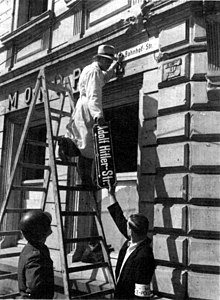
On March 2, 1945 at around 10 a.m., Trier was captured and more than 800 German soldiers were taken prisoner. The conquest of Trier was hailed as a great success by the Americans and made headlines across the country. On March 7, even the commander in chief of the US troops in Europe, the later US President Dwight D. Eisenhower , together with General George S. Patton and the commander of the XX. US Corps, Walton Walker , Trier and awarded Lieutenant Colonel Jack J. Richardson the Silver Star , the fourth highest order in the US Army.
post war period
Trier has belonged to the state of Rhineland-Palatinate since 1946. In 1957, the new synagogue of the Trier Jewish community was inaugurated on Kaiserstraße.
At the end of April 1969, the Roman road was exposed at the Porta Nigra. Shortly afterwards, on May 12, 1969, the game reserve was opened in the Weißhauswald. The university was opened in 1970 , initially as part of the Trier – Kaiserslautern dual university . The development of Trier into a university city continued on April 1, 1974 with the opening of the Martinskloster student dormitory . In 1975 the university became independent. In 1971, the Trier Department of the Rhineland-Palatinate University of Applied Sciences was founded from the previous institutions, the State Engineering School for Construction and Mechanical Engineering Trier and the Trier Craft School . Since 1996 it has been an independent university of applied sciences as Trier University of Applied Sciences (until September 11, 2012 Trier University of Applied Sciences).
Other important events in the 1970s were the discontinuation of the 99-year-old Trierische Landeszeitung on March 31, 1974 and the reopening of the restored cathedral on May 1 of the same year.
From May 24th to May 27th 1984 Trier officially celebrated the city's 2000th anniversary. 1986 were Roman Monuments, Cathedral and Church of Our Lady in Trier by the UNESCO for World Heritage declared. During work on the construction of an underground car park in October 1988, the remains of a Roman thermal baths were discovered under the cattle market . The Trier observatory was officially inaugurated on November 5th . On September 9, 1993, a treasure with 2,558 Roman gold coins was found during excavation work for another underground car park near the Roman bridge . It has an estimated precious metal value of 2.5 million euros.
When the Moselle flooded the century , the water level reached a record high of 11.28 m on December 23, 1993. The Pfalzel district barely escaped a flood disaster.
From April 22nd to October 24th, 2004, the State Garden Show took place on the Petrisberg , which was attended by 724,000 guests.
Incorporations
Formerly independent communities and districts that were incorporated into the city of Trier. Some of the places were already part of the urban area between 1798 and 1851. In 1798 the urban area covered a total of 890 hectares.
| year | places |
|---|---|
| 1888 | St. Paulin, Maar, Zurlauben, Löwenbrücken, St. Barbara |
| 1888 | Outsourcing of Heiligkreuz and Olewig |
| 1912 | Pallien (southern part), Heiligkreuz, St. Matthias, St. Medard, Feyen (with Weismark) |
| 1930 | Yours, Biewer, Pallien (northern part), Kürenz, Olewig |
| 7th June 1969 | Ehrang-Pfalzel (formed on March 1, 1968 through the unification of the two independent municipalities), Eitelsbach, Filsch, Irsch, Kenner Flur, Kernscheid, Ruwer, Tarforst, Zewen |
Population development
At the beginning of the 4th century, Trier, the residence of the Roman emperors, was the largest city north of the Alps with an estimated 80,000 inhabitants. In the Middle Ages and up to the beginning of the modern era, the population declined because of numerous wars, plagues and famines to only 2,677 in 1697. In the 18th century the population of the city grew up to 8,829 in 1801. With the beginning of industrialization in the 19th In the 19th century, population growth accelerated. In 1900 over 43,000 people lived in the city. By 1939 that number had doubled to over 88,000.
During the Second World War, the city lost around 35 percent of its residents (30,551 people). The population sank to 57,000 in 1945. Only in the course of the incorporation of several places on June 7, 1969, the pre-war status was reached again. At the same time, the city's population exceeded 100,000 for the first time, making it a major city according to the official definition . Since the turn of the millennium, the “ official number of inhabitants ” for Trier, according to an update by the State Statistical Office of Rhineland-Palatinate (only main residences and after comparison with the other state offices) has mostly been very little below 100,000. In 2006, the “big city threshold” was exceeded again after the introduction of a second home tax . At the end of 2016, Trier had over 110,000 inhabitants. Nationwide, Trier ranks 75th among the major cities in Germany (as of 2016).
The population statistics do not include the members of the French armed forces stationed in Trier between 1945 and 1999 with their families. At times there were over 30,000 people.
politics
Since 1302, the head of the city of Trier has been the master lay judge , sometimes called the mayor . The mayor was representative of the archbishop's sovereignty over the city. In the 15th century, two mayors were at the head. There was always a dispute with the archbishop about the status of the city. In 1795 the French occupation introduced the collegial municipal constitution . In 1798 the Mairie constitution was introduced and some suburbs were incorporated. In 1801 a new municipal constitution followed, which was essentially retained until 1845, with the mayor holding the title of Lord Mayor from 1818 (Trier had now become a city district). The mayor was also the district administrator of the Trier district (until 1851). In 1856 the city received the " Rhenish Town Code ". The municipal council decided in favor of the mayor's constitution (as opposed to the magistrate's constitution ). With the Prussian Municipal Constitutional Law of 1933 and the German Municipal Code of 1935, the leader principle was enforced at the municipal level . After the Second World War , a mayor was first appointed, who was elected by the city council in 1946. He was initially on a voluntary basis, but since 1949 he has been working full-time again.
Trier is part of the Trier Bundestag constituency and the Trier and Trier / Schweich state constituencies .
City leaders
The city leaders since the 18th century:
- until 1794: Ludwig Karl Gottbill, Mayor of Trier, in the Electorate of Trier
- 1794–1796: Ludwig Karl Gottbill, first Mayor of Trier, in the French era
- 1796–1797: Matthias Gedeon Dupre, Maire
- 1797–1800: Franz Heddesdorf, President of the municipal administration
- 1800–1810: Anton Joseph Recking , Maire
- from 1810: Heinrich Leistenschneider, Maire
- 1815–1817: Anton Joseph Recking, first Lord Mayor of Trier, under Prussian administration
- 1818-1840: Wilhelm von Haw
- 1840 : FA Kayser (acting)
- 1841–1848: Franz Damian Görtz
- 1849–1862: Franz Xaver Buhs
- 1862–1904: Karl de Nys
- 1904–1927: Albert von Bruchhausen
- 1928–1934: Heinrich Weitz , center
- 1934–1938: Ludwig Christ , NSDAP
- 1938–1945: Konrad Gorges , NSDAP
- 1945–1946: Friedrich Breitbach (appointed by the US military administration)
- 1946–1949: Heinrich Kemper , CDU
- 1949–1963: Heinrich Raskin , CDU
- 1964–1976: Josef Harnisch , CDU
- 1976–1979: Carl-Ludwig Wagner , CDU
- 1979–1989: Felix Zimmermann , CDU
- 1989–2007: Helmut Schröer , CDU
- 2007–2015: Klaus Jensen , SPD
- 2015– : Wolfram Leibe , SPD
The Lord Mayor of Trier wears a chain of office made of gold, which shows the old Trier city seal on which the patron of Trier Cathedral, St. Peter and the first bishop of Trier, Eucharius , received the key for the Sancta Treveris (Holy Trier) from Christ.
The former alderman Ulrich Holkenbrink ran for the CDU in the election of the new mayor on September 24, 2006, but was defeated by his opponent Klaus Jensen, supported by SPD and Bündnis 90 / Die Grünen , who is a member of the SPD but ran as an independent candidate, clear. Holkenbrink received 33.1% of the valid votes, Jensen 66.9%. The turnout was 43.2%. The Lord Mayor of Trier has not been appointed by the CDU for the first time since the end of the war on April 1, 2007 . Helmut Schröer did not run again. Wolfram Leibe (SPD) was elected to succeed Klaus Jensen on October 12, 2014 with 50.2% of the vote. He took office on April 1, 2015.
City Council
Next to the mayor of Trier's board includes still the mayor and two full-time councilor . The members of the city council also preside over the four departments .
- Department I: Human Resources, Economics and Finance - Lord Mayor Wolfram Leibe (SPD)
- Department II: Social Affairs, Schools and Sport - Mayor - Elvira Garbes (Greens).
- Department III: Culture, Security and Order - Alderman Thomas Schmitt (CDU), from April 18, 2017; Predecessor: Alderman Thomas Egger (SPD, previously FDP), 2010 to 2016.
- Department IV: Building, Urban Planning, Environment, Transport, - Alderman Andreas Ludwig (CDU), since May 1, 2015.
City council
The city council of Trier consists of 56 honorary council members, who were elected in a personalized proportional representation in the local elections on May 26, 2019 , and the full-time mayor as chairman.
The distribution of seats in the city council:
| choice | SPD | CDU | GREEN | FDP | LEFT | AfD | NPD | PIRATES | UBT 1 | FW | POLITICAL PARTY | total |
|---|---|---|---|---|---|---|---|---|---|---|---|---|
| 2019 | 12th | 13th | 15th | 3 | 4th | 4th | - | - | 3 | 1 | 1 | 56 seats |
| 2014 | 15th | 20th | 9 | 2 | 3 | 2 | - | 1 | 4th | - | - | 56 seats |
| 2009 | 15th | 19th | 10 | 4th | 2 | - | 1 | - | 5 | - | - | 56 seats |
| 2004 | 11 | 21 | 9 | 3 | - | - | - | - | 8th | - | - | 52 seats |
| 1999 | 15th | 24 | 6th | - | - | - | - | - | 7th | - | - | 52 seats |
coat of arms
|
Blazon : "In red, the standing, nimbly and gold-clad St. Peter with an upright, turned-away golden key in his right hand and a red book in his left."
The city colors are gold-red. |
|
| Foundation of the coat of arms: St. Peter as the city's patron has been traceable in the city's seals since the 12th century. The representation of the person changed several times and has been in an upright position since the 15th century. The city colors were not determined until the 19th century. |
Partnerships
In addition to Luxembourg, Metz and Saarbrücken, with which it has merged to form the QuattroPole , Trier is a regional center of the greater region of Saar-Lor-Lux- Rhineland Palatinate-Wallonia.
Trier has nine twin cities :
-
 Gloucester ( United Kingdom ) since May 1957
Gloucester ( United Kingdom ) since May 1957 -
 Metz ( France ) since October 13, 1957
Metz ( France ) since October 13, 1957 -
 Ascoli Piceno ( Italy ) since August 31, 1958
Ascoli Piceno ( Italy ) since August 31, 1958 -
 Herzogenbusch ( Netherlands ) since June 7, 1968
Herzogenbusch ( Netherlands ) since June 7, 1968 -
 Pula ( Croatia ) since September 8, 1971
Pula ( Croatia ) since September 8, 1971 -
 Fort Worth ( United States ) since July 13, 1987
Fort Worth ( United States ) since July 13, 1987 -
 Weimar ( Germany ) since May 24, 1987
Weimar ( Germany ) since May 24, 1987 -
 Nagaoka ( Japan ) since June 2, 2006
Nagaoka ( Japan ) since June 2, 2006 -
 Xiamen ( People's Republic of China ) since November 11, 2010
Xiamen ( People's Republic of China ) since November 11, 2010
Youth parliament
Since the end of 2011 there has been a youth parliament in Trier , which is elected for a two-year term.
religion
story
The Roman Catholic Christianity played and plays an exceptionally important role in the history of Trier.
At the time of the Treveri , Celtic deities were worshiped in the temple districts in Trier-West below the Markusberg at a rock spring ( temple district Irminenwingert ) and in the Altbachtal . In the 2nd century, a Gallo-Roman temple district was created in the Altbachtal with 70 temples and other places of worship on an area of around five hectares.
Constantine the Great , Emperor of the Roman Empire, who temporarily resided in Trier, openly revealed himself to be a Christian from around the year 323. As was customary at the time, Constantine was baptized shortly before his death in 337. Trier has been Christian since Constantine .
Trier was probably already the seat of a Christian bishop at the end of the 3rd century, who later rose to become archbishop. This ruled a spiritual territory that was from 1189 to 1806 one of the electoral principalities of the Holy Roman Empire of the German nation. One of the first German synagogues was built in 1066, and in 1096 a crusader pogrom took place against the Jews of Trier, which the bishop was unable to defend. The Reformation could not gain a foothold in the episcopal city ; however, with Caspar Olevian, one of the most important German Reformed theologians emerged from Trier . Trier remained a predominantly Catholic city; a minority of Trier professed Judaism . In the 17th century the bishopric was partially moved to Koblenz. After the archbishopric was occupied by the French in 1794, the ecclesiastical province was finally dissolved in 1803 and the territory was incorporated into the later Prussian Rhine province in 1815 . In 1821, however, Trier again became the seat of a bishop, whose diocese was rewritten and assigned to the ecclesiastical province of Cologne (suffragan diocese of Trier). The current parishes of the city have formed the Trier deanery within the diocese of Trier since November 2003 .
Trier is an important place of pilgrimage . The sacred skirt (see Archbishop Johann I ) is kept in the cathedral and is exhibited at irregular intervals every few decades. There are also the Holy Rock Days . Another pilgrimage goes to the tomb of the apostle Matthias . According to tradition, the only apostle grave north of the Alps is located in the Benedictine Abbey of St. Matthias (dial. Also St. Mattheis ) . The bones of the Apostle Matthias are said to have been transferred to Trier by the Trier Bishop Agritius on behalf of the Empress Helena , mother of the Roman Emperor Constantine I. The main pilgrimage time is the week around Ascension Day .
After Trier became Prussian, Protestants also came to the city and founded a Protestant parish. After a year as a simultaneous church , the former Jesuit church became a Protestant parish church from 1819 to 1856. Afterwards, the Constantine Basilica , which had been rebuilt for this purpose, was handed over to the Protestant parish church and the Jesuit church again to the Catholics. Through the incorporation of the formerly independent town of Ehrang and other communities west of the Moselle in 1969, what is now the Protestant parish of Trier-Ehrang, which has been independent since 1946, came to Trier with its 1928–1930 church . The municipality of the Evangelical Parish Trier-Ehrang today includes the Trier districts west of the Moselle and roughly the area of the Verbandsgemeinden Schweich , Trier-Land and Ruwer . The Christ Church in the Heiligkreuz district, consecrated in 1963, was given up again in 2014. Today all Protestant Christians in Trier belong to the Evangelical Church District Trier of the Evangelical Church in the Rhineland , unless they are members of a free church .
In addition to Protestant and Roman Catholic parishes , there are other free churches and religious communities in Trier: Evangelical Free Church Congregation ( Baptists ), Free Evangelical Congregation , Adventist Congregation , Free Church Pentecostal Congregation , Christian Congregation , The Christian Community , Congregation of Christ, a New Apostolic Church , Russian Orthodox and several Russian Orthodox Churches Congregations of Jehovah's Witnesses .
The Trier Jewish community, which existed since the Middle Ages, possibly even since antiquity, came from, among others, Karl Marx , Trier's most famous son; many of his ancestors were rabbis in Trier. The Trier bishop Matthias Eberhard also descended from a Jewish family on his father's side; his grandfather had converted to Catholicism .
There is a Buddhist center in Hornstrasse. There is an Islamic cultural center with a mosque on Luxemburger Strasse. The Turkish-Islamic Haci Bayram Camii in Konz is also responsible for Trier.
Under the name "les amis de l'humanité", a Masonic lodge was established in 1805 under Napoleonic rule . This lodge still works today in its lodge house on Brückenstrasse under the name “Zum Verein der Menschenfreunde”.
Trier lies on a Way of St. James that leads pilgrims to Santiago de Compostela .
Denomination statistics
In 2007, almost 67,500 Catholics, around 13,600 Protestants, around 2,000 Muslims and around 500 Jews lived in Trier. At the end of 2012, 63.6% of the population were Catholic and 12.9% were Protestant. 23.2% had no or some other denomination affiliation. At the end of 2018, 56.9% of the population were Roman Catholic, 11.6% Protestant and 31.6% had no or another religion. At the end of June 2021, 53.4% of the population had the Catholic denomination and 10.8% the Protestant. 35.8% either belong to another religion or are non-denominational.
sightseeing features
The Roman buildings, which have been preserved to the present day, were designated as UNESCO World Heritage Roman Monuments, Cathedral and Church of Our Lady in Trier in 1986 .
- The objects of the UNESCO world cultural heritage
Igeler pillar, hedgehog
Antiquity
- Porta Nigra , symbol of the city
- amphitheater
- Thermal baths (Roman baths): Kaiserthermen , Barbarathermen and Viehmarktthermen
- Roman palace auditorium / Konstantinbasilika (today Protestant Church of the Savior)
- Roman bridge
- antique burial ground (over 1000 sarcophagi) under the imperial abbey church of St. Maximin
- Albana Tomb and other Roman burial chambers on the site of the cemetery of the Benedictine Abbey of St. Matthias
- Palatiolum in Trier-Pfalzel with the so-called Küsterhaus, the oldest inhabited Roman stone house in Germany
middle Ages
- Trier Cathedral of St. Peter (oldest cathedral in Germany)
- The Liebfrauenkirche (built in the earliest Gothic style 1227-1243 and connected to the cathedral by a cloister)
- The medieval main market with Steipe , Rotem Haus , St. Gangolf , Marktkreuz , Petrusbrunnen and the nearby Judengasse
- Benedictine Abbey of St. Matthias (Romanesque church with apostle's grave)
- Well-fortified residential towers: Frankenturm , Jerusalem tower , Konviktsturm
- Dreikönigenhaus (early Gothic house)
- Moselle cranes (the older Mosel crane from 1413, also known as the " Alter Krahnen ", and the baroque "(old) customs crane" from 1774, also known as the "Younger Mosel crane")
- Heiligkreuz Chapel in Trier-Heiligkreuz (Romanesque chapel)
- Zewener Turm (Zewen district)
- Former collegiate church in Trier-Pfalzel (today in remains of the transept of the parish church)
- Rosportsches house in Pfalzel and former castle Pfalzel
- Curia von der Leyen , at Domfreihof 5
- Remains of the medieval city wall of Trier , the city wall of today's Ehrang district and the fortifications in the Pfalzel district
17th and 18th centuries
- Electoral palace
- Baroque Kesselstatt Palace
- Löwen-Apotheke am Hauptmarkt (oldest pharmacy in Germany)
- Palais Walderdorff
- Quinter Castle (Trier-Quint district)
- St. George's Fountain
- Baroque basilica of St. Paulin
- former monastery church of St. Irminen
- Monaise Castle with park (Trier-Zewen district)
- St. Jost , chapel, infirmary and former leper cemetery (Trier-Biewer district)
- Old town center of the Pallien district with the courtyard house of the St. Martin Abbey, craftsmen and day laborers houses as well as the church of St. Simon and Juda
1800 to 1933
- French casino
- Old Jewish cemetery on Weidegasse
- Trier main cemetery with tombs from the 19th and 20th centuries, war graves from both world wars, part of the Jewish cemetery
- Art Nouveau houses in the areas of Eberhardstrasse , Fleischstrasse , Nagelstrasse , Neustrasse , Speestrasse and Im Gartenfeld
- Karl Marx House and Karl Marx House
- Maria-Hilf chapel with the grave of Peter Friedhofen , the founder of the order of the Brothers of Mercy of Maria Hilf
- Marian column
- Baldwin fountain
- Catholic church buildings of historicism : neo-Romanesque: St. Martin , Redemptorist monastery St. Josef, neo-Gothic: Herz Jesu, St. Helena (Euren), St. Peter (Ehrang), St. Germanus in Trier-Feyen-Weismark , and modern: monastery church St. Clara of the Poor Clare Monastery on Petrisberg (1930)
- Evangelical Church Trier-Ehrang
- Building the partially preserved barracks : Maximinkaserne (. 1802-ca 1944), Palace Barracks (1,803 to 1,930), Urban Barracks (Trier) ( also Gneisenaukaserne ) (1899-ca 1930). Horn Barracks (Trier) (1889-1930), artillery barracks (Trier) (1912–1928), Goeben barracks (Trier) (1912–1930), Jägerkaserne (Trier-Nord) (1913–1992), Jägerkaserne (Trier-West) (1913–2014), Kemmelkaserne on Petrisberg ( 1936–1999), Neue Hornkaserne (1937–1985), Feyen barracks (1938–1999), General von Seidel barracks (1952–2012).
time of the nationalsocialism
- Trier's high bunker near the town hall
- Former National Socialist teacher training institute (today old buildings on the Schneidershof campus of Trier University of Applied Sciences)
- Former state youth school for the Trier Hitler Youth in Trier-Biewer
- High bunker in Trier-West
- High bunker in Trier-Nord
- High bunker in Trier-Feyen
- Several Westwall bunkers on the border between Trier-Zewen and Igel as well as at Trier-Ruwer (on the Grüneberg and in the direction of Kenn )
post war period
- Trier main cemetery : memorials to the horrors of National Socialism and the world wars: memorial for the victims of the tyranny 1933–1945 , memorial for 92 murdered Polish children, memorial for Soviet prisoners of war, etc.
- Settlement for French officers with buildings in timber frame construction . Built 1948–1950 in Trier Nord (Hochwaldstraße and Wittlicher Straße near Nells Park )
- Former military training area of the French armed forces with artificial ruins for house-to-house combat training and graffiti with African landscapes (above the Trier-Feyen district)
- New construction of the Trier Theater by Gerhard Graubner from 1964
- Churches in the style of brutalism and postmodernism : St. Michael in the Mariahof district - a pyramid-like church built in 1969/70 by the architect K. Schmitz; Churches of the cathedral master builder Karl Peter Böhr : St. Simeon (1966) in Trier-West , St. Agritius im Gartenfeld (1971), Maria-Hilf-Kapelle (Trier) (1990)
- Buildings in the high-altitude districts: water tower on the Petrisberg , telecommunications tower Trier-Petrisberg , buildings of the University of Trier , water band, tower Luxembourg
- Buildings by Oswald Mathias Ungers : Protective structure of the Viehmarktthermen , entrance area of the Kaiserthermen , forecourt of the Constantine Basilica .
- The Karl Marx statue on Simeonstiftplatz was unveiled on May 5, 2018 for the 200th birthday of Karl Marx .
Parks and protected areas
Parks in Trier are the Nells Park and the Palastgarten . The site of the former state horticultural show on Petrisberg has been increasingly urbanized since 2004.
Trier is home to the Gillenbachtal nature reserve (47 hectares), the Kahlenberg orchid biotope at Sievenicherhof (15.5 hectares), Kenner Flur (31.4 hectares), gravel pit near Oberkirch (4.7 hectares) and Mattheiser Forest (447 hectares) is also designated as a fauna-flora-habitat area. See also: List of nature reserves in Trier .
Trier is located in the area of protected landscape areas Meulenwald and city forest Trier and the Moselle valley .
As landscape elements the areas have hedges in Trier-Eitelsbach , Former beer garden Löwenbrauerei and on the right bank of the Moselle between Nordbad and customs of the crane trees on Moselradweg Trier protected. There are also numerous natural monuments in Trier .
Culture
As a city in the Greater Region , Trier took part in the program of the European Capital of Culture 2007 with the Constantine Exhibition.
The exhibition Nero - Emperor, Artist and Tyrant was held in 2016.
On the occasion of Karl Marx's 200th birthday in 2018, the Great State Exhibition KARL MARX 1818–1883 was held from May 5 to October 21, 2018 . LIFE. PLANT. TIME. both in the Rheinisches Landesmuseum Trier as well as in the City Museum Simeonstift Trier including further exhibitions in the Museum Karl-Marx-Haus and in the Museum am Dom .
theatre
- Theater Trier (opera, operetta, musical, ballet, drama) with studio stage
- Trier Antique Festival (1998 to 2010)
- Kleines Volkstheater Trier (amateur play in Trier dialect since 1990)
Museums
- Rheinisches Landesmuseum (including a replica of the Igel column , ancient finds, mosaic floors, Neumagen wine ship )
- Episcopal Cathedral and Diocesan Museum
- City Museum Simeonstift (including city model)
- Karl Marx House
- Toy museum (tin toys, etc.)
- Treasury of the Trier City Library (manuscripts, Gutenberg Bible , Coronelli globes, maps, stained glass)
- Folklore and open-air museum Roscheider Hof (located in Konz directly on the border with Trier and was founded in 1973 by the district of Trier-Saarburg and the cities of Trier and Konz)
- Haus des Waldes (forest museum) at the Drachenhaus in the Weißhauswald, game reserve, educational forest trail (Trier-Pallien)
- Transport Museum Trier
Visual arts
Art associations
- Art Association Trier Young Art
- GB KUNST, Society for Fine Arts Trier
Galleries
- Young Art Gallery
- Gallery Kaschenbach
music
Choirs
- Trier Boys' Choir
- Trier Bach Choir
- DOM Music Trier
- Trier Domsingknaben
- Girls' choir at Trier Cathedral
- Trier Cathedral Choir
- Vocal ensemble Dom zu Trier
- Trier concert choir
- Extra choir at the Trier Theater
- Collegium Musicum of the University of Trier
- Friedrich Spee Choir
- Gospel Voices Trier e. V.
- Mixed choir St. Medard e. V.
- Polyhymnia women's choir
- Cantores Trevirenses
- Men's Choir Trier-Euren 1912 e. V.
- Trierische Liedertafel 1835 e. V.
- Police Choir Trier 1981 e. V.
- Choir of the Supervision and Service Directorate
- Mixed choir Cäcilia 1888 Trier-Zewen
- Choir of the SWT Stadtwerke Trier 1913.
- Treveris Choir Trier-Olewig 1913 e. V.
orchestra
- Philharmonic Orchestra of the City of Trier
- Collegium Musicum of the education and media center in Palais Walderdorff
- Collegium Musicum of the University of Trier
- "Da capo" Orchestra Ehrang 1999 e. V.
- Reservist music train Trier 1966, the oldest reservist music train in Germany
Music festivals
- International organ days in Trier Cathedral
- Summer cycle of organ concerts in the Basilica of Constantine
- Summerblast Festival in the Youth and Culture Center Excellence House
- Moselle music festival with national and international stars and orchestras
carnival
The Trier Carnival is one of the largest carnival festivals in Rhineland-Palatinate, making Trier one of the major Rhenish carnival, Mardi Gras and Mardi Gras strongholds .
Youth centers
Youth centers exist in Trier-Nord ( Excellence House ), Trier-Zentrum ( Mergener Hof / MJC ), Trier-Mariahof, Trier-Euren, Trier-Süd, Trier-Kürenz and Trier-Ehrang.
Cinemas
In the city center, two theaters that exist cinema Broadway movie theater and the multiplex cinema CinemaxX . The cinema landscape is complemented by the programs of the F.ab! of the Cineasta , the Unifilm and the film club Le Septième Art e. V.
Events
In Exhaus (short for Exzellenzhaus) and the Tufa (short for textile mill) concerts of different styles. Larger concerts are held either in the Messeparkhalle , Europahalle or, since June 2003, in the newly built Trier Arena .
The art gallery of the European Art Academy regularly organizes thematic exhibitions and vernissages with artists from home and abroad as well as panel discussions, studio visits, summer festivals and concerts.
- Trier Carnival
- May to September: Trier summer meeting
- May to September: various local and wine festivals: Zewener strawberry fair, Kürenz fair
- May: European folk festival in the fair park
- June: Old Town Festival (last weekend in June), Peter and Paul Mass
- July: Christopher Street Day
- July: Zurlaubener Heimatfest. One of the most beautiful quarter festivals takes place in the picturesque, former fishing village of Zurlauben (vernacular: "Zalawen"), which is located directly on the Moselle .
- August: Olewiger Wine Festival
- August: Heiligkreuzer Brunnenfest
- August: Trier-Feyen wayside shrine festival
- August: Flower Days in Trier
- August: Ehranger market
- September: Palatinate fair
- October: Trier wine market from Mosel-Saar-Ruwer
- End of October / beginning of November: All Saints' Day Mass
- November / December: Christmas market in the city center
- December / January: Trier Christmas Circus on the exhibition grounds
Sports
According to the 2012 sports club survey, there are 112 sports clubs in Trier. A total of 21,297 athletes are organized in the 67 clubs that took part in the survey, with 39.7 percent women being underrepresented. The club with the largest number of members is the Post-Sportverein Trier with 3300 members. Around 83 percent of all functionaries in the associations surveyed work on a voluntary basis. The most popular sports are football for men and gymnastics for women.
Ball sports
The football team Eintracht Trier made it to the semi-finals in the 1998 DFB Cup and narrowly missed participation in the European Cup after a penalty shoot-out. In the summer of 2002, after a long period of abstinence, she made it to the second division , but rose again in 2005 to the regional league and a year later to the upper league. Currently (2019/2020) Eintracht plays in the football league Rhineland-Palatinate / Saar .
Trier has been represented in the basketball league since 1990 by TVG Trier, now TBB Trier . In the 2007/08 season, the club was determined to be relegated, but was able to maintain the league through a wildcard process. One of the greatest successes was winning the German Cup twice in 1998 and 2001. The women's handball team of the DJK / MJC Trier ("The Kitties") has played in the 1st Bundesliga since 2000 and won the German championship in 2003. Women's handball and basketball teams play their home games in the Trier arena. The wheelchair basketball team RSC-Rollis Trier also plays in the 1st Bundesliga, they play their home games in the Mäusheckerhalle.
American sports also established themselves in Trier. The baseball team of Trier Cardinals won the German Cup in 1995 and the 1996th After the withdrawal of sponsors, however, a long decline began soon afterwards. They currently play in the regional league of the Southwest German Baseball and Softball Association. V. (SWBSV). The mixed softball team took third place in the unofficial German softball mixed championship in 2007.
Another American sport, American football is represented by two teams in the city. The Trier Stampers of the Post- Sportverein Trier were founded as early as 1990, and until they were re-established in 1998 they still bore the name Trier Saints. In 1999, they only just missed entry into the 2nd Bundesliga. In the past two seasons (2013/2014), the men's team won the championships. At the moment the men's team plays in the regional league, the youth team in the youth league. Another football team are the Trier Wolverines , which were founded in January 2008 and reached second place in the youth development league with their youth team in the same year. In 2009 the newly founded men's team of the Wolverines established itself. The club goes on the air regularly with its American football magazine GRIDIRON on the local television station OK54 and reports on the Rhineland-Palatinate League and American football in general.
There is also a rugby team that plays in the 3rd Bundesliga South-West . She plays for FSV Trier-Tarforst .
Motorsport
In August, the Rallye Deutschland , which has been part of the World Rally Championship since 2002 , was held in Trier and the surrounding area from 2000 to 2016 . The International Trier Hill Climb was organized from 1971 to 2011 by the Racing Team Trier 1967 e. V. and has been a run for the European Mountain Championship since 1991 .
Other sports
- The largest popular sports club in Trier is the Post Sports Club, with over in sports offered in as many departments, some of which are also active in the field of competitive sports.
- The chess club SG Trier in 1877 belonged to the 2007 to 2017 Schachbundesliga on.
- The Trier Go section of the German Go Federation plays as a team with Luxembourg (TriLux) in the 2nd Bundesliga. The Trier Go Group is characterized above all by a successful youth work, from which both the German youth champion 2014 and the German school team champions of the years 2014 and 2015 ( Friedrich-Wilhelm-Gymnasium ) emerged.
- The Trier New Year's Eve run takes place regularly on December 31st. It is considered to be one of the best-filled year-end runs in Europe and is called the “German São Paulo” based on the famous Brazilian New Year's run .
- The Trier Canoe Drivers 1948 Association (TKF) is located near today's modern Römerstadt youth hostel in the former youth hostel building (Hans-Karl-Schmitt-Haus). He celebrates national and international sporting successes in canoeing.
- The Skydiving Club Trier e. V. , based at the Trier-Föhren airfield , was founded in 1975.
- The PBC Trier plays in the 2nd Bundesliga pool .
- Swimming pools are Das Bad an den Kaiserthermen , the North outdoor pool and the South outdoor pool.
Economy and Infrastructure
In 2016, Trier achieved, within the city limits, a gross domestic product (GDP) of € 4.741 billion and was 65th in the ranking of German cities by economic output . In the same year, GDP per capita was € 42,142 (Rhineland-Palatinate: € 34,118, Germany € 38,180). The GDP per labor force is 58,640. In 2016, the city's GDP grew nominally by 0.3%, compared to 4.7% in the previous year. In 2016, around 80,900 people were employed in the city. The unemployment rate in December 2018 was 4.3% and thus slightly above the average for Rhineland-Palatinate of 4.1% (in the neighboring district of Trier-Saarburg it was 2.5%).
In the Future Atlas 2016 , the independent city of Trier was ranked 206 out of 402 districts, municipal associations and independent cities in Germany and is therefore one of the regions with a “balanced risk-opportunity mix” for the future.
Debt of the city of Trier
In 2011, the city's budget had an income of 301 million euros and expenditure of 364 million euros. 63 million euros had to be financed through loans. In total, the city of Trier owed 581 million euros. In terms of per capita debt, Trier was fifth among the independent cities in Rhineland-Palatinate with 6,174 euros. This was the result of an analysis commissioned by the Trier Chamber of Commerce and Industry .
The debt in 2016 was 714,641,290 euros and thus 6,545 euros per inhabitant. At this point in time, all independent cities in Rhineland-Palatinate had a per capita debt of 5,626 euros.
traffic
Inner-city private transport
For tens of thousands of people who commute daily between the Moselle valley and the high-altitude districts ( Tarforst , Filsch , Irsch , Kernscheid ), the university and the suburbanized towns beyond the city limits, there are only three possible approaches on the road: On the one hand, a road leading south of the Petrisberg through the district of Olewig , on the other hand the axis in the north over the coal road through the Avelertal in the district of Kürenz . There is also the possibility of reaching the Petrisberg with its emerging residential area, the university buildings and the technology park via Sickingenstrasse, which opens up the plateau via serpentines past the amphitheater .
The areas mentioned are burdened by heavy through traffic, which has increased significantly in the last decade, due to the rapidly increasing number of students at the university, a sharp rise in the number of residents due to new residential areas in the high-altitude districts and the steadily increasing number of companies employed on the Petrisberg. A discussion about relief through bypasses is in progress, especially in Kürenz. In order to protect the residents here, a greater burden on the residents from the heavy goods vehicle traffic in the area of Olewiger Strasse was accepted. So far, however, all considerations for relief roads or alternative transport concepts have failed due to the financial aspects. From 2010 to 2012, discusses the Petri mountain climb via separate public transport - route to realize, in the meantime it is hoped Express buses through the Moselbahn breakthrough , however, for there is still no completion date. The other problem is that Trier does not have a bypass for north-south traffic and therefore the corresponding traffic has to use the four-lane road on the eastern bank of the Moselle.
Supraregional road traffic
The following motorways lead to / from Trier:
-
 Luxembourg (there Autoroute 1
Luxembourg (there Autoroute 1  ) –Trier
) –Trier -
 leads from Kenn over the Moselle bridge Ehrang to Trier-Ehrang
leads from Kenn over the Moselle bridge Ehrang to Trier-Ehrang -
 leads from the Trier distribution circle to the Moseltal motorway triangle and from there to the A1
leads from the Trier distribution circle to the Moseltal motorway triangle and from there to the A1
The ascent of the Moselle and the Meulenwald autobahn as western and northern bypasses of Trier are under discussion .
The following federal highways run through the city area:
-
 Border crossing Wasserbillig (L) –Trier – Koblenz
Border crossing Wasserbillig (L) –Trier – Koblenz -
 Border crossing Hanweiler (F) –Saarbrücken – Trier – Bitburg – Cologne
Border crossing Hanweiler (F) –Saarbrücken – Trier – Bitburg – Cologne -
 Trier – Schweich – Mehring – Bernkastel-Kues – Zell – Alf
Trier – Schweich – Mehring – Bernkastel-Kues – Zell – Alf -
 Trier – Losheim am See – Heusweiler – Riegelsberg – Saarbrücken
Trier – Losheim am See – Heusweiler – Riegelsberg – Saarbrücken
Transportation
Local public transport is largely operated by the bus lines of Stadtwerke Trier (SWT). In addition, numerous non-synchronized regional bus routes from various bus companies operate in Trier. The tariff of the Verkehrsverbund Region Trier (VRT) applies on all Trier bus routes .
The Trier tram also existed from 1890 to 1951 . It was replaced by the Trier trolleybus introduced in 1940 , which was discontinued in 1970.
bridges
For almost two millennia, the path to the left bank of the Moselle led only over the Roman bridge , the first version of which was built in 18 BC. BC / 17 BC Was built. It was not until the beginning of the 20th century that the Kaiser Wilhelm Bridge followed as the second river crossing; In 1973 the Konrad-Adenauer-Brücke was added, which since then has been the last road bridge completely within Germany (the next bridge leads 18 km upstream from Wellen to Grevenmacher). The Pfeiffersbrücke in Ehrang, the building erected in 1949, bridges the Koblenz-Trier railway line and connects the Servaisstraße with the B 53. There is also a railway bridge between the Pfalzel and the north industrial area (Moselle route Trier-Koblenz), popularly known as the " Pfalzeler Brücke ", which also enables pedestrians and cyclists to cross the Moselle. In the north of the city lies the Ehrang Moselle Bridge on the 64a federal motorway between Trier-Ehrang and Kenn , which also enables pedestrians and cyclists to cross the Moselle. It connects the A 602 and B 53 , but due to its location also has an inner-city development function. The Konz Moselle Bridge leads from Konz to Trier-Zewen . It connects the Saar line and the Upper Moselle line with the Trier western line . In Trier-Pallien , the Napoleon Bridge spans the valley of the Sirzenich brook . It is part of the federal highway 51 . The Aulbrücke in St. Matthias crosses the railway line between the Trier Südbahnhof and Konz-Karthaus. Other bridges are the Biewerbachtalbrücke or the Gartenfeldbrücke .
Rail transport
The main station is located in the northeast area of the city center between the districts of Mitte-Gartenfeld and Nord . Trier is connected to the north via the Moselle route to Koblenz and via the Eifel route to Cologne; to the south, the Trier western route to Luxembourg , the Saar route to Saarbrücken and the Upper Moselle route to Perl and Metz (France) . Continuous trains run from Koblenz to Saarbrücken and on to Mannheim or Luxembourg as well as Mondays to Fridays from Wittlich to Perl, otherwise the Trier main station is usually the terminus. Further stops are in the northwest of the city center Quint , Ehrang-Ort , Ehrang and Pfalzel , in the south Trier Süd . From December 11, 2005 to December 10, 2011, the city of Trier had a direct ICE connection to Berlin. Directly to the north of the main train station is a Deutsche Bahn depot (formerly Trier depot). In Ehrang there is a former marshalling yard , which, however, is still used to a lesser extent as a freight yard by Deutsche Bahn AG . In June 2008, the state of Rhineland-Palatinate decided that the Trier western line between Trier-Ehrang and Trier-Zewen should be reactivated for passenger traffic, in particular to improve connections for commuters to Luxembourg. In addition, the construction of two new train stops Trier Nord (probably near Dasbachstraße) and Trier-Kaiserthermen (probably near Hermesstraße) is planned on the Moselle route .
air traffic
The closest airport for national and international connections is Luxembourg Airport , around 40 kilometers away. About 25 kilometers from the city center is the Trier airfield, which was moved from Trier-Euren (in operation from 1910 to 1977) to Föhren . To Frankfurt-Hahn Airport is about 70 km and the Saarbrücken Airport is around 105 km away.
shipping
With the canalization of the Moselle between 1958 and 1964 to become an international large shipping route, Trier is connected to the industrial area of Lorraine, the state of Luxembourg, the western German industrial centers and the North Sea ports in the Netherlands and Belgium via inland waterways. Trier is the seat of the Moselle Commission, founded in 1962, to regulate all matters relating to shipping on the Moselle. The Trier Port Company, founded in 1962, completed the commercial and industrial port in Trier-Ehrang in 1965 . When it opened on May 26, 1965, Trier became a port city. The port of Trier is a transshipment point for goods traffic, which mainly consists of the transport of crude and mineral oil as well as ores and metal waste. An expansion of the port facility has also allowed containers to be handled since 1998. The port facility is directly connected to the road and rail network.
Tourist attractions are the Moselle trips on passenger ships both to Luxembourg and in the direction of Koblenz.
The Trier Waterways and Shipping Office existed since 1952 and came in 2019 through a merger with the offices in Koblenz and Saarbrücken to form the Mosel-Saar-Lahn Waterways and Shipping Office with a location in Trier on Pacelliufer .
Network of cycle and hiking trails
The Moselle cycle path leads through the city and is part of the international cycle route Velo Tour Moselle . The Kylltal cycle path into the Eifel starts in Trier-Ehrang and the Ruwer-Hochwald cycle path into the Hunsrück starts in Trier-Ruwer . The Nahe-Hunsrück-Moselle cycle path runs between Bingen am Rhein and Trier.
In general, the cycle path network in the Trier city area is moderately developed. Cyclists in particular who move around the city often have to switch to narrow, busy streets and accept the corresponding safety risks. The ADFC assessed the situation for cyclists in Trier in 2010 as “poor to sufficient”. However, Trier received the “3rd place in the 2014 ADFC bicycle climate test”. Catch-up price in the city size group 100,000 to 200,000 inhabitants and is now in 29th place out of 37 (lower 22%) (cf. 2012: 39 of 42: lower 8%).
Trier forms a junction in the Rhineland-Palatinate network of hiking trails . In addition to the Eifelsteig , the Saar-Hunsrück-Steig also has its start and end point here. A dream loop on the Saar-Hunsrück-Steig is the Trier Galgenkopftour , a 15.8 km long high-altitude path that includes , among other things. leads to the Naumeter head . The Moselhöhenweg runs through the city of Trier both on the Eifel side and on the back of the Huns. Since April 2014 Trier has also been connected via the Moselsteig Trail, which alternates on both sides of the Moselle valley . The Ausoniusweg from Trier to Bingen am Rhein has also been dedicated as the Hunsrücker Jakobsweg since June 2013 .
Other traffic
Park-and-ride parking spaces are available both in the south-west ( Messepark ) and in the north (riverside / distribution circle ) of the city. For larger events, the Trier University car park at Schneidershof also serves as a park-and-ride car park. On the Saturdays in Advent, three special free P + R lines are offered every 10 minutes (financing is provided by the City Initiative), otherwise the parking spaces are served by normal scheduled services.
As part of the withdrawal of the French armed forces , the vacated areas will be used for conversion . There are plans to build a hotel and apartments on the former “Castel Feuvrier” between the Moselle and Zurmaiener Strasse. Offered for sale by the Federal Agency for Real Estate Tasks (Bima), the conversion site was acquired by Real Estate Company Rhineland-Palatinate (IRP) for Porta Nova GmbH. Helmut Klein was the managing director of both companies until January 31, 2012.
company
With JT International and Heintz van Landewyck , Trier forms a center of the German cigarette industry. Other larger companies or public institutions are:
- Sparkasse Trier , 930 employees
- Stadtwerke Trier , 750 employees
- Steil Holding GmbH , 700 employees
- Steep crane work
- Köhl Maschinenbau GmbH , 600 employees
- Natus GmbH & Co. KG , switchgear systems 520 employees
- Defense technology department for land-based vehicle systems, pioneer and troop technology , 420 employees
- Tax office Trier , 400 employees
- Michelin (preliminary products for tires), 220 employees
- Volksbank Trier , 300 employees
- Zweckverband ART , 300 employees
- Landal GreenParks (Headquarters Germany)
- Karlsberg Brewery GmbH & Co. KG
- Leyendecker HolzLand GmbH & Co. KG , founded in 1860, 130 employees
- Volksfreund -Druckerei Nikolaus Koch GmbH (publisher)
- MAN Nutzfahrzeugvertrieb GmbH (sales and maintenance)
- Romika (shoe manufacturer)
- Schloss Wachenheim AG (sparkling wine producer)
- Peter Herres wine and sparkling wine cellar
- Bernard-Massard Sektkellerei GmbH
- Alwitra Flachdachsysteme GmbH & Co
- WestRock Packaging Systems Germany GmbH
- TRIWO AG , project developer and portfolio holder of commercial, industrial and special real estate , active nationwide
- Mercedes-Hess GmbH & Co. KG
- Joh. Rendenbach jr. GmbH & Co. KG , one of the last tanneries to work according to the traditional Eichenloh pit tanning process
medicine
The city of Trier takes on the function of a high-level medical center for the former Trier administrative district as well as the high forest region and parts of the Saarland, with maximum care services and specialist medical care in the outpatient sector. Only basic and standard care hospitals with 100 to around 300 beds are still located in the medium-sized centers in the area, some of which are threatened with closure in the medium term. In the area of the city of Trier there were originally six clinics, since the closure of the Sacred Heart Hospital in 2006 there have been five. In 2016, after the parent company took over the clinic in Ehrang and the former Protestant Elisabeth Hospital, there were only three. The city's clinics now have a total of 1,667 beds. In the Middle Ages there was also the St. Jakobs Hospital and the Leprosorien St. Jost in Trier .
- Clinic mother house of the Borromäerinnen , 667 beds, 2500 employees
- Brothers of Mercy Hospital (Brothers Hospital) , 612 beds, 2400 employees
- Clinic mother house of the Borromean women Trier-Nord (182 beds)
- Clinic mother house of the Borromean women Trier-Ehrang (181 beds)
- Geriatric Rehabilitation Clinic St. Irminen, 80 beds, a social facility of the United Hospitien
media
Since the Trierische Landeszeitung was discontinued in 1974, the Trierische Volksfreund (TV) has been the only regional daily newspaper . In addition, the “Rathauszeitung” is distributed free of charge to all municipal households as an official bulletin for official announcements. The Wochenspiegel , which is distributed to all households as a weekly newspaper, is also free of charge . In the area of online media, there are several online portals / city magazines that are subject to a certain fluctuation, such as currently (2016) 5vier.de, Lokalo.de or trier-reporter.de. One of them was the local news site “ 16vor ” from 2007 to 2014 , which was also published as a printed magazine from 2014 to 2015. There is also a studio of the public broadcasting company Südwestrundfunk (SWR), which broadcasts the regionalized radio program SWR4 Rhineland-Palatinate temporarily from Trier, as well as a regional studio of the state-wide private radio broadcaster RPR1 . Citizens' television OK54 emerged from the Trier Open Channel, which was founded in 1987.
Since Saturday, November 13th 2010, Cityradio Trier has taken over the broadcast frequencies from 884 Trier . The private Rhineland-Palatinate radio station uses the 88.4 MHz Trier-Petrisberg , 94.7 MHz Wittlich and 87.8 MHz Welschbillig frequencies , which were formerly used by Antenne West . An "Adult Contemporary" (AC) format is broadcast and can be received in Trier and the surrounding area.
- Transmitting systems in Trier: Telecommunications tower Trier-Petrisberg , SWR transmitter Trier-Markusberg , transmitter Trier
training
Universities
- University of Trier , founded in 1473, closed in 1798 and re-founded in 1970 as part of the University of Trier-Kaiserslautern, made independent in 1975
- Trier University of Applied Sciences , founded in 1971 through the merging of several predecessor institutions as the Trier department of the Rhineland-Palatinate University of Applied Sciences . Became independent in 1996 as Trier University of Applied Sciences. Since September 12, 2012 Trier University of Applied Sciences, with locations in Trier, Birkenfeld and Idar-Oberstein.
- Theological Faculty of Trier , organizationally independent university in close cooperation with the University of Trier (including use of the university's premises and services)
High schools
- Friedrich-Wilhelm-Gymnasium (FWG), one of the oldest schools in Germany, founded in 1561 as a Jesuit college
- Humboldt-Gymnasium Trier (HGT), until March 31, 2009 Hindenburg-Gymnasium Trier
- Max Planck High School (MPG)
- Auguste-Viktoria-Gymnasium Trier (AVG)
- Friedrich-Spee-Gymnasium (FSG)
- Angela-Merici-Gymnasium (AMG), episcopal high school for girls
- Free Waldorf School Trier (FWS)
- Vocational high school for health and social affairs (GGS), upper level at the BBS Nutrition, Housekeeping and Social Affairs (BBS EHS)
- Wirtschaftsgymnasium (WG), upper level at the BBS Wirtschaft (BBS W)
- Vocational high school for media and design technology (GMG), upper level at the BBS trade and technology (BBS GuT)
- Technical high school (TG), upper level at the Balthasar-Neumann-Technikum (BNT), sponsored by the Trier-Saarburg district
Elementary schools
- Primary school on the Biewerbach
- Ambrosius Elementary School
- Ausonius Elementary School
- Barbara Elementary School
- Episcopal primary school at the cathedral
- Egbert elementary school
- Free Waldorf School
- Gregor von Pfalzel Elementary School
- Feyen primary school
- Heiligkreuz primary school
- Trier-Irsch primary school
- Johann Herrmann Primary School yours
- Keune Elementary School Kürenz
- Primary school Mariahof
- St. Martin Primary School
- Matthias Elementary School
- Elementary School Olewig
- Pallien Primary School
- Primary school St. Peter Ehrang
- Quint Primary School
- Reichertsberg primary school
- Ruwer Primary School
- Tarforst primary school
- Zewen Elementary School
Realschulen and Realschulen plus
- Blandine-Merten secondary school
- Kurfürst-Balduin-Realschule plus
- Nelson Mandela Secondary School plus
- Moselle Valley Realschule plus Trier
- St. Maximin Private School
More schools
- Integrated comprehensive school Trier, Montessoriweg
- Free Montessori School Trier e. V., at the youth hostel
- Balthasar-Neumann-Technikum (FS), technical college , sponsored by the Trier-Saarburg district
- St. Helena School Trier , vocational school
Special schools and specialty schools
- St. Josef private school
- Medard School
- Porta Nigra School
- Treverer School
- Wilhelm Hubert Cüppers School
Academies
- European Art Academy Trier - free art academy, founded in 1977 by Erich Kraemer
- German Judges Academy
- European Law Academy - training center for lawyers in European law
- European Academy of Rhineland-Palatinate Sports
Other public institutions
Trier is the seat of one of two federal treasuries as well as a branch of the Federal Agency for Real Estate Tasks .
Judicial authorities are the District Court of Trier , the Trier Regional Court , the Labor Court Trier , the Social Court Trier , the Administrative Court of Trier , the prosecutor Trier or the prison Trier in Trier-yours.
In Trier there is a federal police station , the state police headquarters in Trier , the technical relief organization Trier as well as the defense technology department for land-based vehicle systems, pioneer and troop technology of the Bundeswehr in Trier-Kürenz, the audit office Rhineland-Palatinate (head office Speyer) has a branch office.
Other institutions are the Trier fire brigade , the Trier Chamber of Crafts and the Trier Student Union .
Personalities
Panoramas
Trier as a namesake for other places
- New Trier is a place in Dakota County in Minnesota , United States.
- New Trier Township is a township in Cook County, Illinois , United States. The New Trier Highschool belongs to the New Trier Township and has an image of the Porta Nigra in its logo.
- Neu-Trier was a mission station in the former German colony of German East Africa . Today: Mbulu (Iraqw Imboru, German formerly Neu-Trier) is the capital of the district of the same name in the Manyara region in Tanzania .
See also
literature
Generally
- Jort Blazejewski, Stephan Laux , Nina Schweisthal (eds.): Sources on the history of the city of Trier in the early Prussian period (1815–1850) (= publications from the Trier city archive, vol. 4), Verlag für Geschichte und Kultur 2018; 941 p .; ISBN 978-3-945768-04-4 .
- Gabriele B. Clemens , Lukas Clemens : History of the city of Trier . Munich 2007, ISBN 978-3-406-55618-0 .
- Lukas Clemens : Trier - A wine town in the Middle Ages. (= Trier historical research. Volume 22). Trier 1993, ISBN 3-89890-018-5 .
- Elisabeth Dühr and Christl Lehnert Leven (eds.): Under the tricolor, Trier in France - Napoleon in Trier, 2 volumes, Trier 2004.
- Jens Fachbach, Stefan Heinz, Georg Schelbert, Andreas Tacke (eds.): Trier architecture guide. Imhof, Petersberg 2015, ISBN 978-3-86568-728-9 .
- Marcello Ghetta: Late Antique Paganism. Trier and the Trevererland. Kliomedia , Trier 2008, ISBN 978-3-89890-119-2 .
- Joachim Gilles, Karl-Josef Gilles : On the way through Trier by tram and trolleybus from 1935 to 1970. On the rails. Sutton 2007, ISBN 978-3-86680-223-0 .
- Gottfried Kentenich : The history of the city of Trier from its foundation to the present: Memorandum for the hundredth anniversary of the city's membership of the Prussian state / ed. by Gottfried Kentenich. Lintz, Trier 1915.
- Hermann Kickton : The prehistoric times of the Trier region. Society for useful research on Trier , Trier 1925.
- Michael Matheus : Trier at the end of the Middle Ages. Studies on the economic, social and constitutional history of the city of Trier from the 14th to the 16th century. (Dissertation 1981) Trier 1984 (= Trier historical research , 5).
- Heinz Monz (complete editing): Trier Biographical Lexicon. Verlag der Landesarchivverwaltung Rheinland-Pfalz , Koblenz 2000, ISBN 3-931014-49-5 .
- Heinrich Silbergleit: Prussia's cities. Memorandum for the 100th anniversary of the city regulations dated November 19, 1808 (published on behalf of the board of the Prussian Association of Cities). Berlin 1908.
- Rheinisches Landesmuseum Trier (ed.): Trier: Augustus city of the Treverians. Town and country in pre and early Roman times. 2nd Edition. Von Zabern, Mainz 1984, ISBN 3-8053-0792-6 .
- Rheinisches Landesmuseum Trier (Ed.): Trier: Imperial residence and episcopal city. The city in late antique and early Christian times. 2nd Edition. Mainz 1984.
- City book of Rhineland-Palatinate and Saarland . Volume IV 3rd part of the German city book. Urban History Handbook. On behalf of the Working Group of the Historical Commissions and with the support of the German Association of Cities, the Association of German Cities and the German Association of Municipalities, ed. by Erich Keyser. Stuttgart 1964.
-
University of Trier (ed.): 2000 years of Trier. 3 volumes. Spee, Trier 1996-1997.
- Heinz Heinen : Trier and the Trevererland in Roman times. Spee, Trier 1985, ISBN 3-87760-065-4 .
- Hans Hubert Anton , Alfred Haverkamp (ed.): Trier in the Middle Ages. Spee, Trier 1996, ISBN 3-87760-066-2 .
- Kurt Düwell , Franz Irsigler (ed.): Trier in the modern age. Spee, Trier 1988, ISBN 3-87760-067-0 .
- Heinrich Volbert Sauerland : Trier historical sources of the 11th century . Trier 1889. Digitized
- Edith M. Wightman: Roman Trier and the Treveri. Hart-Davis, London 1970.
- Thomas Zuche (Ed.): StattFührer. Trier under National Socialism. 2nd Edition. Spee, Trier 1997, ISBN 3-87760-057-3 .
Monument topographies
- Patrick Ostermann (arrangement): City of Trier. Old town. (= Cultural monuments in Rhineland-Palatinate. Monument topography Federal Republic of Germany . Volume 17.1 ). Wernersche Verlagsgesellschaft, Worms 2001, ISBN 3-88462-171-8 .
- Ulrike Weber (arrangement): City of Trier. City expansion and districts. (= Cultural monuments in Rhineland-Palatinate. Monument topography Federal Republic of Germany . Volume 17.2 ). Wernersche Verlagsgesellschaft, Worms 2009, ISBN 978-3-88462-275-9 .
Web links
|
Further content in the sister projects of Wikipedia:
|
||
|
|
Commons | - Media content (gallery) |
|
|
Wiktionary | - Dictionary entries |
|
|
Wikisource | - Sources and full texts |
|
|
Wikivoyage | - Travel Guide |
- Official website of the city of Trier
- Link catalog on Trier at curlie.org (formerly DMOZ )
- Dilibri - digital editions of books about Trier
- Trier - Römisches Erbe ( Memento from March 28, 2010 in the Internet Archive ) (website for the TV program Treasures of the World of the SWR)
- Poverty under the eyes of the young Marx. A media station on the social topography of Trier around 1832 . Cooperation project of the professorship for historical regional studies at the University of Trier, the Research Center Europe and the Trier City Museum on the occasion of the state exhibition KARL MARX 1818–1883. LIFE. PLANT. TIME. from May 5th to October 21st 2018
- History page
- Literature from and about Trier in the catalog of the German National Library
Individual evidence
- ↑ State Statistical Office of Rhineland-Palatinate - population status 2020, districts, municipalities, association municipalities ( help on this ).
- ↑ Walter Blasius: Die Trier Switzerland , self-published, Trier 2017.
- ^ Deutsche Fotothek : Mes table sheet No. 6205: Trier, 1887
- ↑ landkartenarchiv.de: Mes table sheet No. 6205: Trier, 1939
- ↑ Trier topographic map, 2019 edition, DNB 1204588309
- ↑ Trier districts
- ↑ Stadt-Fokus 03 | 2019, Small-scale structure of the city of Trier - structure and explanations, Office for Urban Development and Statistics, Raimund Fries, Prof. Dr. Weinand, pp. 3-6 , accessed July 2, 2020
- ↑ Source: Deutscher Wetterdienst, mean values were determined from the basic data of the Trier-Petrisberg weather station itself
- ↑ Heat records in Germany
- ^ Economic forum: Rostock proves to be a regiopole , North German News , April 21, 2016
- ^ Expensive living in Trier. In: Trierischer Volksfreund. October 11, 2011.
- ↑ Birgit Gehlen, Ingrid E. Koch, Hartwig Loehr, Tanja Zerl: Middle Stone Age find complexes of the 9th millennium in the Trier district (Rhineland-Palatinate): Chronological context, raw material supply and activity spaces , in: Archäologische Informations 40 (2017) 161-200 ( academia .edu ).
- ↑ Georg Kistinger: Determination of the city foundation day of the Roman Trier. Retrieved August 11, 2017 . As well as building on this: Georg Kistinger: The sun brings it to light . In: Trierischer Volksfreund . February 4, 2004 ( volksfreund.de ).
- ^ Helmut Bernhard : The Roman history in Rhineland-Palatinate. The development up to the tetrarchy. In: H. Cüppers (Ed.): The Romans in Rhineland-Palatinate. P. 125.
- ↑ Eugen Ewig : The Merovingians and the Franconian Empire. 5th edition. Kohlhammer, Stuttgart 2006, ISBN 3-17-019473-9 , pp. 12-16.
- ↑ Matthäus Merian's engraving from 1646 is very similar to the woodcut of Trier from 1548 in Sebastian Munster's Cosmographiae Universalis (title: Situs & figura antiquissimae & praecipuae Medioniatricum ciuitatis Treuirensis), which is considered to be the first authentic cityscape of Trier. Although Merian's view is more detailed than the woodcut, it does not depict structural changes that were made between 1548 and 1646 (e.g. to the Basilica of Constantine). Comparison of the woodcut in the Latin edition of Cosmographiae Universalis from 1550 on Historic Cities
- ↑ Reinhard Scholzen : Franz von Sickingen (1481–1523): Feud as a profession. In: Austrian military magazine. 5, 2014, pp. 523-531.
- ^ Paul Wagner: Philipp Christoph v. Sötern . In: Allgemeine Deutsche Biographie (ADB). Volume 26, Duncker & Humblot, Leipzig 1888, pp. 50-69.
- ↑ Wolfgang Adam, Siegrid Westphal: Handbook of cultural centers of the early modern period: Cities and residences in the old German-speaking area . De Gruyter, Berlin 2012, p. 1924 ( excerpt from Google book search).
- ^ Franz-Josef Heyen : The Archdiocese of Trier. Walter de Gruyter, 1972, ISBN 3-11-002273-7 , p. 117.
- ↑ Entry on the former Gruneberg ski jump in the database of cultural assets in the Trier region ; Retrieved September 25, 2017.
- ^ City of Trier - Doughboys, Pershing and Old Glory. Retrieved October 19, 2020 .
- ^ "Reiner Nolden, Trier City Archives, on the homepage of the Trier State Horticultural Show 2004" according to the entry on Petrisberg - History (Trier) in the database of cultural assets in the Trier region ; accessed on September 15, 2015.
- ↑ Ernst Mettlach: When US troops took the Roman Bridge in a coup. Retrieved March 5, 2020 .
- ↑ "www.ibiblio.org", p. 134 (last page)
- ↑ Official municipality directory 2006 ( Memento from December 22, 2017 in the Internet Archive ) (= State Statistical Office Rhineland-Palatinate [Hrsg.]: Statistical volumes . Volume 393 ). Bad Ems March 2006, p. 198 (PDF; 2.6 MB). Info: An up-to-date directory ( 2016 ) is available, but in the section "Territorial changes - Territorial administrative reform" it does not give any population figures.
- ^ Michael Rademacher: German administrative history from the unification of the empire in 1871 to the reunification in 1990. City and district of Trier. (Online material for the dissertation, Osnabrück 2006).
- ↑ Official population of Trier on December 31, 2016
- ↑ Table of the Federal Statistical Office
- ↑ trier.de
- ^ Xiamen, the ninth twin town of Trier. trier.de, accessed on November 16, 2010 .
- ^ City of Trier - youth election and youth parliament. In: www.trier.de. Retrieved January 24, 2020 .
- ↑ Elizabeth Dühr, Frank G. Hirschmann, Christl Lehnert-Leven: urban history at the City Museum. Trier 2007, ISBN 978-3-930866-24-3 .
- ↑ Marcus Stölb: Lots of church resignations . (No longer available online.) In: 16vor. March 19, 2010, archived from the original on March 25, 2010 ; accessed on October 22, 2017 .
- ↑ Trier in figures - population overview - religious affiliation 2012–2018 , accessed on July 27, 2019
- ^ City of Trier municipal statistics , accessed on July 1, 2021
- ↑ trier-story.de ( Memento from February 6, 2013 in the Internet Archive )
- ^ Entry on Kurie von der Leyen in the database of cultural assets in the Trier region ; accessed on September 15, 2015.
- ↑ Entry on former Redemptorist Monastery Sankt Josef - Church (Trier) in the database of cultural assets in the Trier region ; Retrieved September 18, 2015.
- ^ Entry on Herz Jesu (Trier) in the database of cultural assets in the Trier region ; Retrieved September 17, 2015.
- ↑ Entry on St. Helena (Trier (Euren)) in the database of cultural assets in the Trier region ; accessed on September 17, 2015.
- ^ Entry on St. Peter (Trier (Ehrang)) in the database of cultural assets in the Trier region ; Retrieved September 17, 2015.
- ^ City of Trier - Protected Areas , accessed on May 31, 2015
- ^ Website Extrachor
- ↑ Sports development concept of the city of Trier, Part A, Trier 2013, p. 44f.
- ^ Bundesliga of the German Go Federation
- ^ Website of the Trier Go Group
- ↑ Trier Youth Hostel , portrait of the Roman City Youth Hostel in Trier
- ↑ Current results - VGR dL. Retrieved January 7, 2019 .
- ^ Federal State of Rhineland-Palatinate. Federal Employment Agency, accessed on January 7, 2019 .
- ↑ Zukunftsatlas 2016. (No longer available online.) Archived from the original ; accessed on March 23, 2018 .
- ^ Greetings from Mayor Klaus Jensen on the participatory budget of the city of Trier. (No longer available online.) Archived from the original on November 28, 2012 ; accessed on October 22, 2017 .
- ↑ Debt continues to rise. In: ihk-trier.de. Retrieved June 6, 2012 .
- ↑ Debt at statistik.rlp.de
- ↑ Marcus Stölb: End of the line for the Petrisberg ascent . (No longer available online.) In: 16vor.de. June 6, 2012, archived from the original on February 10, 2013 ; accessed on October 22, 2017 .
- ↑ Holger Dietrich, “Roman Emperors in Germany. The archaeological guide ”, Holger Sonnabend and Christian Winkel, Darmstadt / Mainz 2013, p. 75 para. 2
- ↑ New platforms: Deutsche Bahn is planning more stops - the city relies on Trier-Nord and Kaiserthermen. In: volksfreund.de , July 14, 2016, accessed October 15, 2016
- ↑ On two wheels in Trier - a balancing act. In: 5vier.de , October 13, 2010.
- ↑ City ranking ADFC bicycle climate test 2014 ( Memento from April 2, 2015 in the Internet Archive )
- ↑ From 2014: Hiking on the Moselsteig Trail. Rhineland-Palatinate Tourism website. Retrieved April 16, 2014.
- ↑ Christiane Wolff: Castel Feuvrier: riverside town with dock as the Baltic Sea. In: Trierischer Volksfreund. December 18, 2011.
- ↑ Christiane Wolff: Castel Feuvrier: A Private's done. In: Trierischer Volksfreund. January 11, 2012 / Christiane Wolff: Castel Feuvrier: Sale completed . In: Trierischer Volksfreund. January 25, 2012, p. 10.
- ↑ Website of the Brothers of Mercy Hospital
- ↑ Online portal 5vier.de
- ↑ Lokalo.de
- ↑ trier-reporter.de
- ↑ radioszene.de
- ^ Federal Treasury Trier.
- ↑ Federal Agency for Real Estate Tasks ( Memento from July 18, 2011 in the Internet Archive )







